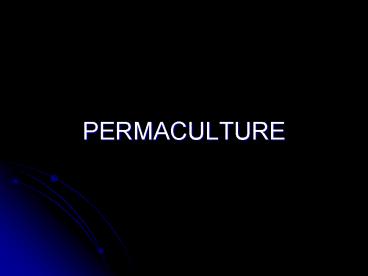PERMACULTURE - PowerPoint PPT Presentation
1 / 11
Title:
PERMACULTURE
Description:
... 1978 by Bill Mollison, an Australian ecologist, and one of his students, David Holmgren. It is a contraction of 'permanent agriculture' or 'permanent culture. ... – PowerPoint PPT presentation
Number of Views:5297
Avg rating:3.0/5.0
Title: PERMACULTURE
1
PERMACULTURE
2
INTRODUCTION
- The word "permaculture" was coined in 1978 by
Bill Mollison, an Australian ecologist, and one
of his students, David Holmgren. It is a
contraction of "permanent agriculture" or
"permanent culture. - Permaculture is about designing ecological human
habitats and food production systems. - Permaculture is a design system for creating
sustainable human environments.
3
- ORIGIN
- In mid 1970 , two australians Bill Mollison and
David holmgren, started to develop ideas that
they hoped could be used to create stable
agricultural systems, This was the result of
their perception of a rapidly growing use of
destructive industrial and agricultural methods.
They saw that these methods were poisoning land
and water reducing Biodiversity, removing the
billions of tons of soil from previously fertile
landscapes. - A design approach called PERMACULTURE was
their response and was first made public with the
publication of PERMACULTURE ONE in 1978.
4
- CHARACTERISTICS
- Permaculture is one of the most holistic,
integrated systems analysis and design
methodologies found in the world. - Permaculture promotes organic agriculture which
does not use pesticides to pollute the
environment. - Permaculture aims to maximize symbiotic and
synergistic relationships between site
components. - Permaculture is urban planning as well as rural
land design. - Permaculture design is site specific, client
specific, and culture specific.
5
- Permaculture design includes the interaction
between organisms and their surroundings. - The ecological processes of plants, animals,
water, weather and nutrient cycles are integrated
with human needs and technologies for food,
energy, shelter and infrastructure. - Permaculture is not limited to plant and animal
agriculture, but also includes community planning
and development, use of appropriate technologies. - Many of the appropriate technologies advocated by
permaculturists are well known. Among these are
solar and wind power, solar greenhouses and solar
food cooking.
6
- A cropping system refers to growing a combination
of crops in space and time. - An ideal cropping system should
- use natural resources efficiently
- provide stable and high returns
- do not damage the environment
7
- Commonly practiced cropping systems are
- Crop rotation practices
- Intercropping systems
- Mixed cropping systems
- Ratoon cropping
8
- Crop rotation is the practice of growing a series
of dissimilar type of crops in the same space in
sequential seasons - Crop rotation simply means not growing the same
crop on the same place each year, thus reducing
disease build up. - Another important reason for rotation is to make
use of fertiliser left over from the previous
crop. - .
9
- Growing the same vegetables in the same spot each
year can lead to problems. Soil
living pests and diseases, which thrive on that
particular crop, can build up in the soil to
epidemic levels. - Vegetables also have various mineral needs and
continuous cropping of one particular crop can
lead to the levels of nutrients in the soil
becoming unbalanced. - To prevent the build up of pests and diseases in
the soil and to help the vegetables in their
nutrient needs, your crops need to be rotated. It
is a fact that vegetables prefer to be grown in
soil that has been used for a different crop
previously than in soil that has been used for
one of their own kind.
10
- Some of the general purposes of crop rotation
are - improve or maintain soil fertility,
- check erosion,
- reduce the build-up of pests,
- spread the workload on family labor, use of
bullocks and farm equipment, hired labor etc. - less reliance on agricultural chemicals,
- increase net profits
11
- Crop rotation can also improve soil structure and
fertility - by alternating deep-rooted and
shallow-rooted plants - Crop rotation avoids a decrease in soil
fertility, as growing the same crop
repeatedly in the same place eventually depletes
the soil of various nutrients.































